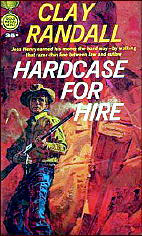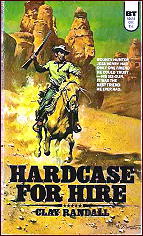SELECTED BY DAVID VINETARD:

B. M. BOWER “The Spook Hills Mystery.” Popular Magazine, November 7, 1914. Published in hardcover as The Haunted Hills, Little Brown, 1934, and in paperback by Popular Library, #306, 1951. Also available online here, among other websites.
“The Spook Hills Mystery” begins rather tritely with the arrival of young Easterner Shelton C. Sherman with a typically cantankerous old hand named Spooky (Gabby Hayes before there was one, “He was not a bad sort, though he was an awful liar when the mood seized him…â€) who leads him on about the “ghost†of Spook Hills, but then popular Western writer B(ertha) M(uzzy) Bower, creator of Chip of the Flying U and a long series about that outfit, throws us a curve.
This, as a beginning, may sound a bit hackneyed. Since the first story was told of the West, innocent young males have arrived in first chapters and have been lied to by seasoned old reprobates of the range, and have attained sophistication by devious paths not always unmarked with violence. But when you stop to consider, life itself is a bit hackneyed.
At least she noticed, and it is far from the only curve in this tale.
Sherman, soon to be known as Shep, is greener than the greenest greenhorn who ever lived, and about to join the Sunbeam Outfit (in “that part of Idaho which lies south of the Snake …â€) to make a man out of him at the hands of Aleck Burney, who has a way of putting youngsters “on the fence†to make “men†out of them in the time-honored way of obnoxious bullies who are supposed to be makers of men in popular fiction from time immemorial. Never let it be said Ms Bower ever missed a cliché when one was at hand (enter Wallace Beery, or the older John Wayne, making men by breaking their spirit since time began).
Shep’s parents have sent him West, all pretty 6’ 2†of him: “… to get some width to go with my length: Dad’s an architect. He said he’d have to use me for a straight edge if something wasn’t done pretty soon.”

The Sunbeam Ranch itself is harbinger of “a keen sensation of disappointment,†otherwise little more than a dirt shack seen over by the giant Burney, who typically tries to establish dominance first thing by a crushing handgrip. Give old Shep this, it hardly bothers him.
Soon he starts to get the hang of things, and they brighten a bit when he meets Vida, daughter of Sam Williams and niece of Uncle Jake and part of a sheep herding outfit, and that should tell you a bit about where this is going, though it is hardly enough, because that is another of Bower’s curves.
Bower knew a great deal about life on a ranch, in fact too much for her readers’ own good, since some of her books spend more time on the drudgery and boredom of actually living on and running a ranch than any good Western can take. Realism combined with a certain Polyannaish view and too few doses of adventure and melodrama makes for an uncertain read for many. For all her beautifully described scenery and realistic views of frontier life you can find yourself wishing Max Brand would show up and kick a few doors down. You wish a few of those “Gosh Darn†moments were at least “Gol Dangs.â€
This one is made of sterner material than that though, and soon Shep has gotten a glimpse of Spooky’s Spook, a critter that leaves a footprint like a bear, if a bear was big as an elephant. Of course we all know he can’t leave that alone any more than he will the feud building between the Sunbeamers and the sheep herders.
And he certainly doesn’t leave bad enough alone, tracking the “thing†to a tunnel where, “The terrible silence was split suddenly by a scream. Human, it sounded, and yet not human, but beastly — horrible. Shelton dropped the candle and clung to the rock beside him. His heart, he thought, stopped absolutely. His very knees buckled under him while he stood there. And then he heard something running, somewhere, even while the cave was playing horribly with the echoes of that scream. Running down that other passage with long leaps, it seemed to him, and the beat of four padded feet upon the rock floor.â€

Where’s Sherlock Holmes when you need him, or for that matter Allan Quatermain? From an Indian woman Shep learns Burney’s father was killed by a “big bear†in Montana, which might explain why Burney objects more to his hunt than his friendship and budding romance with Vida, it also makes it unlikely the sheep killer preying on the Williams herd is Burney. Shep has a mystery to solve.
Then Uncle Jake is killed in the sheep camp while Burney is away in Pocatella, though the herders don’t believe it, and Vida wants his blood.
“I find,” replied the coroner, “that the deceased undoubtedly came to his death by having his neck broken by twisting. Four ribs were broken also, evidently by crushing. There are no bullet wounds — the only other marks of violence on the body being some scratches on the scalp behind the ear. These, I judge, were made by finger nails, in gripping the head to twist it.”
Burney is free. He never made the prints the jury viewed. When the wagon where Vida sleeps is attacked in the night and she hears: “a hoarse scream …. Human—and yet not human—mocking, maniacal, horrible. The most awful sound that Vida had ever heard in her life; a squall, a cry — a shriek she could not find a name for. Her memory flew back to the tales of ghosts and demons that an old Scotch woman had told her years ago. Warlock — that was it! A warlock, such as Maggie MacDonald had told about, that haunted the heath behind the village where strange deaths occurred periodically in the dark of the moon. When men and women were found strangled — and none knew how or why.†And then Vida sees the creature pursuing one of the herders, “the huge figure of a man who came on with
giant strides, leaping clean over what bushes came in his way.â€
And then, and then … Shep drops entirely out of the picture. One of the cowhands, Spider, takes up with Vida, they solve the mystery, and all Shep gets is a letter home, while Spider gets the girl.
Uh, wow.
The action is everything you could hope for and Bower handles the atmosphere and building sense of danger and threat with the skill of a pro. Some of the passages describing the country and the setting border on beautiful, and for all the Western lingo, it’s not too trying, to this reader at least. If the rather juvenile saga of the Flying U is all you know of Bower’s Westerns, this one will clear your sinuses, it’s a humdinger.







